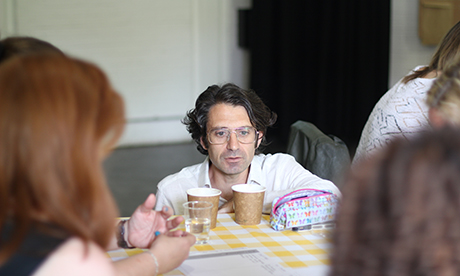‘We don’t want a pub quiz in Year Two’: an interview with Jonny Allams
Jonny Allams works with schools in Hackney and elsewhere, helping teachers to become more creative without losing sight of the skills and concepts needed for effective learning.
This is a high aim indeed – particularly one year on from the introduction of a new national curriculum. Schools also have to cope with the ever-increasing workload and performance pressures, which Allams acknowledges have “definitely got worse.”
I asked him what makes Hackney distinctive from an educator’s perspective. “The potential for what can be brought into the classroom in terms of pupils’ experiences, and the diversity of that, is massive”, explains Allams.
“If you wanted to explore the world, then in Hackney classrooms you can do that – geographically and metaphorically.” Allams mentions ‘Stories from Other Cultures’ – a national curriculum ‘book genre’ for primary schools. “I always think: who is the other in Hackney? Let’s just call them stories!”
“What’s great is when, as a teacher, you don’t teach traditional tales, but learn traditional tales! There’s much more fun to be had in the activities you can do, and cognitively. Do you know a story like this? Can we get your parents in to talk about it? This story says ‘I’ll huff and I’ll puff!’, what does your story say?” One of the greatest opportunities in Hackney schools, says Allams, is that there are “people with first-hand experience of lots of different things, sitting right next to you on the carpet.”
Opportunity not problems
It’s refreshing that his first thought about Hackney schools is related to opportunity rather than problems. Allams highlights the fact that “children all over the world have a set of needs that must be met in order to make them happy,” to provide a foundation for their learning.
He adds that “it would be difficult to argue that, in inner city schools, the nature and number of the needs that seem to be at odds with suddenly launching into learning how to do division, is not greater… that’s where the nature of the job might change from being in an inner city school.”
Allams aims to enable teachers to harness the individuality of children. He’s fighting the good fight in what many would argue is an uphill battle.
He concedes that schools are getting more and more prescriptive. Schools, teachers and children are arguably being stripped of their distinctiveness; “you might as well say, let’s just have one tannoy and we’ll teach them all… and that’s depressing. All schools are being judged against the same standards, to come up with the same goods.” The key, says Allams, is the need “to accept that there are a variety of exciting goods.”
With the current standardisation of expectations, there are always children who, no matter how hard they try, are painfully aware they aren’t ‘succeeding’. Witnessing the impact on their self-esteem can be disturbing. Allams agrees: “If your curriculum is getting narrower and narrower, you’re going to have more and more children who aren’t blossoming.”
Child-centred learning
Against these odds, Allams’s attitude is resoundingly positive; “There is definitely still scope for schools to tread their own path.” And the path he promotes in schools is one cemented in creativity. What Allams does is different; he aims actively to avoid the trend of fine-tuning what it looks like for children to be creative. His creativity is one that should be evident in all learning.
“And rather than being led by changing policies or theories, it’s child-centred. “If a young child’s not using prepositions, the best thing you can do is give them a magnifying glass.” Where is the ant? It’s under the leaf. To those who practise or advocate more ‘conventional’ teaching strategies, this might sound far-out – but in fact, Allams doesn’t identify with any teaching approaches that could be deemed ‘alternative’.
His ethos is grounded in a much simpler premise: that we need to be teaching “young humans – and young animals play. They play at being adult.” He believes that children can and should access the curriculum through engaging and hands-on activities that foster children’s innate and individual imaginations and creativity.
“By six years old, kids have got to know how many oceans there are in the world”, Allams notes. Anyone can learn such facts, but he would rather get children thinking: “Have they always been that way? How much water is there? What is an ocean? What’s the beauty in knowing about oceans?” Essentially, he says, “We don’t want a pub quiz in Year Two.”

